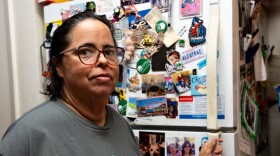Bruce Coons, Executive Director, Save Our Heritage Organization: Old town is not only important to San Diego's history, it's important to the history of the United States. It's one of the most important places in the western United States. It's the result of the first European settlement in 1769 being founded on the hill above Old Town, and Old Town spread out from that. It is the west coast equivalent of Plymouth Rock.
To most San Diegans and tourists, Old Town State Historic Park is a colorful place to have a margarita, buy a tee shirt, and maybe look at an old building or two. In this state park, the food and festivity are the easy part. It is preserving the history of this seminal village that is difficult."
This part of the park was recently the object of a legal tug-of-war between the state of California and concessionaire Diane Powers, who ran the very popular Bazaar del Mundo for some 35 years. In 2003, the state awarded the contract for this commercial corner to Delaware North. When the legal fisticuffs were over in 2005, Diane Powers was out and Delaware North was in, much to the outrage of many San Diegans. Do you know what the community was afraid of?
Steve Casad, Director Delaware North: "I don't think the community knew what was going to happen to it. Our responsibility when we came on board was to remove everything that was not period specific. And that was when we created the blank slate and that blank slate was the first thing that the locals saw, and they go, 'Oh what have you done?' You've taken everything away."
In addition to coping with a furious public, Delaware North had agreed to start from scratch, transform the area into something it never was, and keep it open while they were doing it. It is proving to be a costly project.
In addition to the changeover to Delaware North, one reason for poor attendance in Old Town may be because the history of the pueblo of San Diego is a blank slate to many San Diegans. The pueblo began around 186 years ago, when the first Spaniard ventured down from the fort on the hill into Indian Territory.
Victor Walsh, historian, California State Parks: "Most people were up on the presidio hilltop and they began to come down here at the tail end of the Spanish era - 1820s -- what would have been down here would have been gardens, corrals, a few adobes. But at that time there still was considerable resistance by the native Kumeyaay and settlement actually didn't begin until 1821 when Comandante Ruiz built the first adobe."
The Spaniards ceded control to the Mexicans in 1822, and adobe houses began to crop up near the river. The large Bandini and Estudillo houses were built, and Pio Pico, the last Mexican governor of California, had an elegant house here. Americans arrived with the end of the Mexican and American War in 1848. The Bandini house became the improbably named Cosmopolitan Hotel.
Stores were built and the little town was bustling. And then along came new San Diego and Alonzo Horton, and by 1872, it was all over. Old Town's heyday had lasted just 50 years. It shrank into a forgotten, filthy backwater as the center of town shifted west. By the time the area became a state historic park in 1964, much of the history the state wanted to preserve was already gone, including many old adobes.
There's been 50 or 60 that have been lost. The Pico house comes to mind as one of the most important structures. It was the residence of one of the governors of California and the commander of the army. It was the de facto capital of California for a period of time. It was a very magnificent structure with 15 to 18-foot ceilings, four-foot thick walls. The Pio Pico House was allowed to melt away. But some buildings survive from the Mexican and American eras."
Coons: "There are a number of adobes in old town state park from the 1820s. There's the Estudillo house. There's the Bandini house. And there are some more from the 1830s."
Walsh: "There are five adobes and most of these are restorations with considerable rehabilitation. Some of them are not in their original locations. The most important building dating back to that time -- because basically it has not been restored -- is the Casa de Bandini, the two story building on the far side of the plaza and that was converted into the Cosmopolitan Hotel in 1869 by Albert Seeley who came from Texas."
The historic structures in the state park are a mixed bag, some from the Mexican era and some from the American era, and some, like this Richard Requa motel, from much later.
So when the state Department of Parks and Recreation asked for proposals to operate the concessions in the Bazaar del Mundo area, it wanted to be sure visitors got more than just a colorful dining and shopping experience.
Walsh: "Its mission is to attempt to recreate a semblance -- and I stress the word semblance -- of this sacred ground, this historic spot, as it existed in the 1820s through the 1870s. There are issues there in terms of what the public wants, and what is feasible, given that there have been extensive environmental changes here. We're surrounded by freeways. The course of the original San Diego River used to come right down Taylor Street."
It's also expensive. Not a lot of maintenance and upkeep occurred over the last 35 years, and the state required the winning bidder to put up $2 million in renovations and repairs.
The winner would also fork over 7.3 percent of gross receipts, or $2 million a year, whichever is greater. As gross receipts are down over 60 percent this year, the company is paying the two million. Delaware North won the bid because it promised much more than asked for by the state. The company is putting $12 million into facilities improvements, mostly to the Cosmopolitan Hotel.
Casad: "We have to re-do the roof. We have to re-do the second floor. We have to seismic retrofit the building also, so there's a lot that we have to do to the building to maintain it."
David Marshall of Heritage Architecture is responsible for restoring the hotel and the Plaza to their former glory. The Cosmopolitan Hotel with its added story presents a challenge, a word applied to this project by almost everyone associated with it.
David Marshall, President, Heritage Architecture: "Well, the Cosmopolitan Hotel is the oldest of the buildings we're dealing with. It was originally built in the 1820s and then the second floor was added in 1869. It's an adobe structure on the ground level. So what we're doing is stitching it together using epoxy and steel and supplementing it with wood blocks and things. So it's really intended to hold the building together."
Finn: "What will it look like?"
Marshall: "Well, there's a great historic photograph that shows what it looked like in the 1870s when it was the Cosmopolitan Hotel. People wouldn't recognize it. It's unbelievable how much it's been altered over the time. It still has charm and interest, but when you look at how its been altered with the railings being removed and the posts being removed and the roof being redone and big stucco columns being added and tile stairs, none of those things were original to the historic period."
These are mud blocks that were put together with the labor at the time. Those are still there. It had various coats of plaster that have been redone, but it's in pretty good shape under there. All of our missions in California are adobe, so if they're maintained they do last many hundreds of years.
I want somebody to be able to stand outside this building when it's completed, hold that historic photograph in their hands and not be able to tell that anything was done to it in the past 140 years."
The same problems that beset the Cosmopolitan Hotel plague the Requa motel and adjacent bar, now called the Jolly Boy Tavern: lack of seismic retrofitting, lack of disabled access, crumbling roof tiles, outdated kitchens and restrooms. Delaware North, which, of course, refers to these hurdles as challenges, is taking them one at a time.
Casad: "We expect to start the demolition and construction of the Jolly Boy. We expect that to take about four months. And when we're finished with that -- up and ready to go -- we'll come over to the Cosmopolitan. And we expect that to be September, October in order to make that happen."
Finn: "So in other words, you're going to be -- in the height of tourist season -- you're going to be renovating the Jolly Boy essentially."
Casad: "Yes. You know that is one of our challenges, certainly, In hindsight, if we could have closed when we had taken over to spend six or seven months to make all the changes, and then you have your grand re-opening of the Old Town Historic Park, we would have done that. But it was part of the proposal and the contract that we would stay open and operate, and our challenge when we get to the Cosmopolitan will be trying to keep it open as much as we can during the renovation. We hope the Cosmopolitan will be open before Cinco de Mayo next year. And then we'll begin on the Mexican commercial corner or Plaza del Pasado area right after that."
Back at the Plaza, the somewhat confusing lay of the land is this: Plaza del Pasado is the new name of the former Bazaar del Mundo. It occupies the former Casa de Pico Motel. It now features shops and the Casa de Reyes Mexican restaurant, which used to be the Casa de Pico Mexican restaurant.
Marshall: "Well this is a terrific building. It's a Spanish revival style building built in 1939. The architect was named Richard Requa. He was a very well known architect, [with a] large body of work in San Diego. The most unique challenge that we have is that this building was built outside of the historic period of Old Town, but it still has a lot of historic character and it was built in the style of buildings from that period as a pseudo adobe structure. All we have to do is restore it back to that 1939 period with a few updates and upgrades and it'll fit right into the historic Old Town."
Historic Old Town became the state's most popular park because people loved the festive commercial atmosphere in the Bazaar del Mundo. Now Old Town is undergoing a painful and expensive transition into something different as the state attempts to bring the commercial and the historic into balance.
Walsh: "This is supposed to be a tourist hub. And people come down here. And I think you can, however, meld those distinctions -- what was here historically and what is here currently. There are ways to do that."
Finn: "Meld the historical with the commercial."
Walsh: "Right."
Public acceptance of the effort, especially among San Diegans, is still a question mark. It seems fairly certain that Delaware North will take a financial beating, at least until the Cosmopolitan Hotel is finished. But to many, the effort and the challenges are well worth it.
Coons: "I mean people don't understand today that this is where modern civilization on the west coast actually began.
I think the state park is making a major effort to finally fulfill its mission to present some of the most important structures in the state in their proper setting and their proper use."





